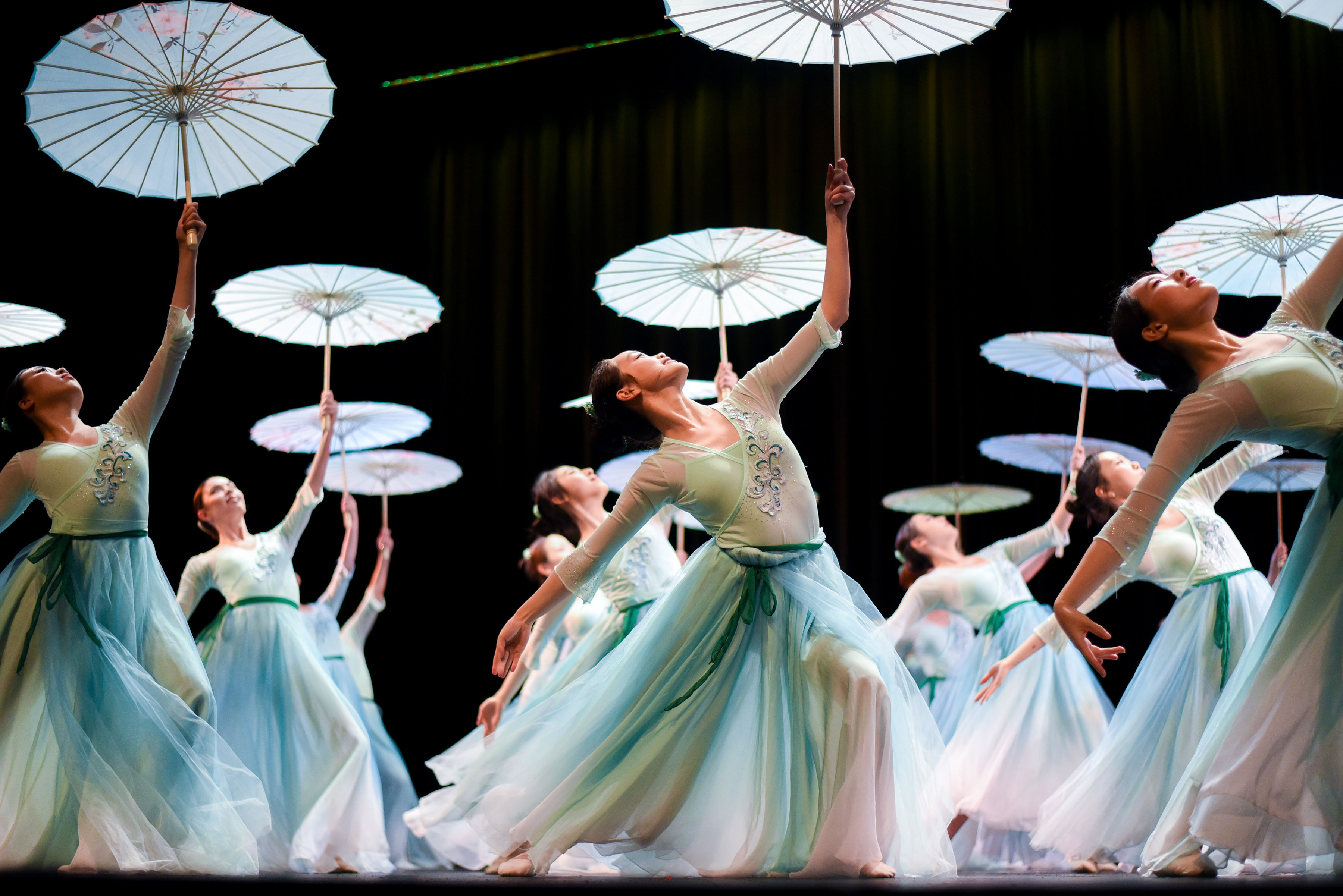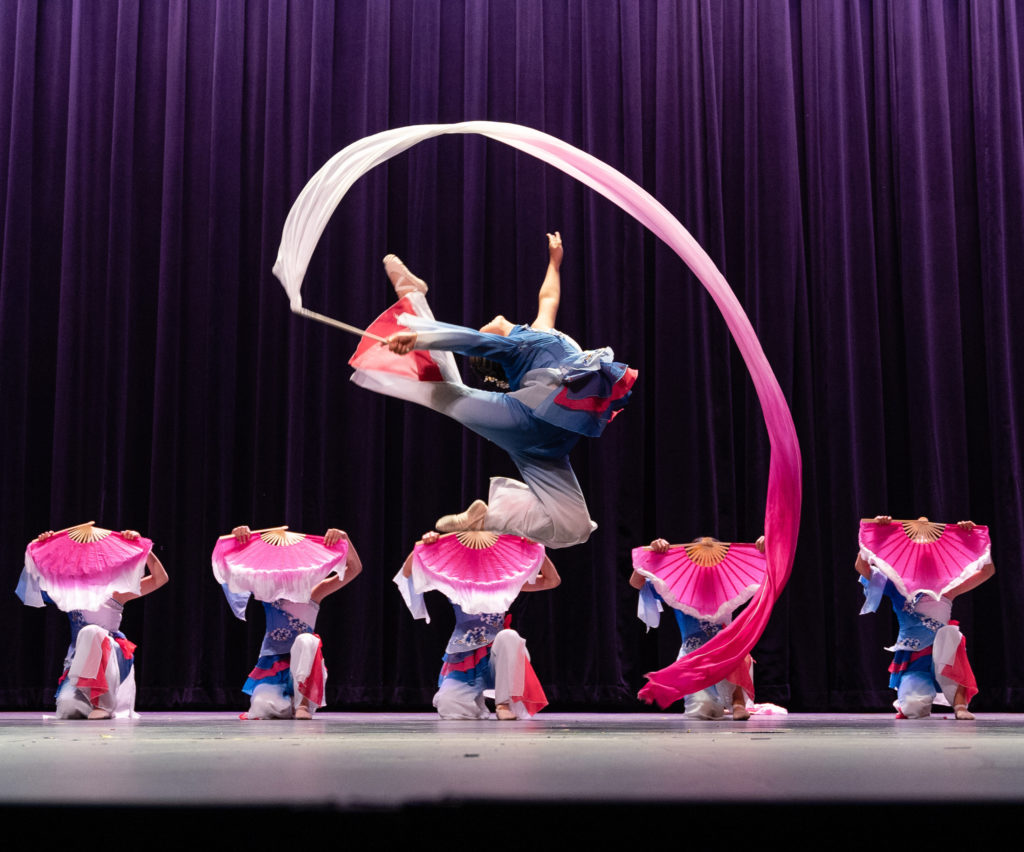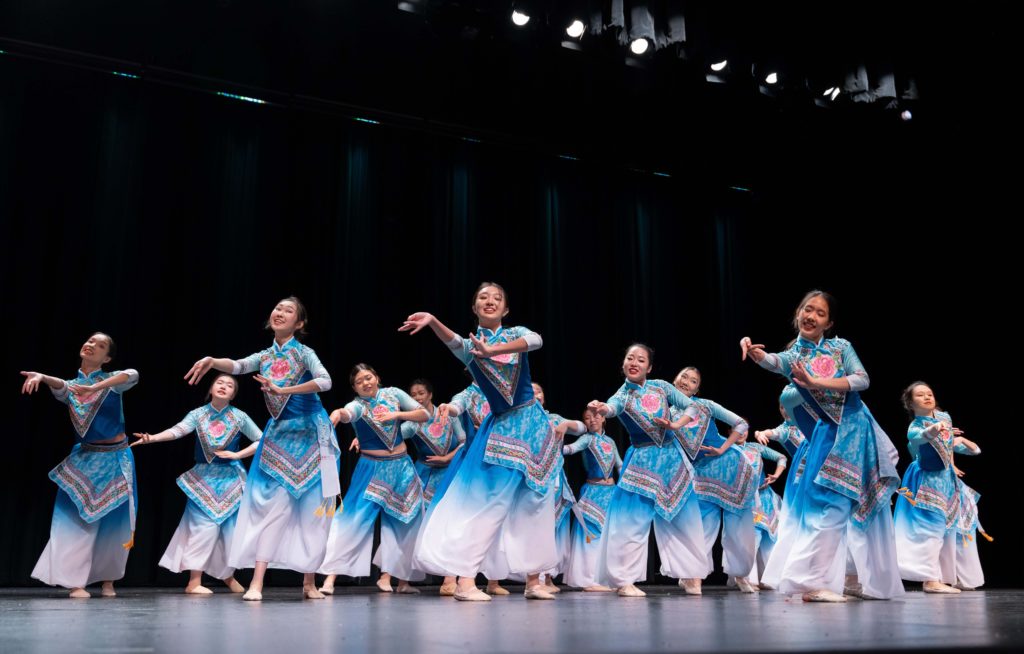Chinese Cultural Dance Club at UCLA uses performing arts to celebrate, educate

Draped in flowing turquoise fabrics, dancers perform while holding parasols on stage. The Chinese Cultural Dance Club hosts their annual Lotus Steps performance every spring. (Courtesy of Melinda Chang)

By Reid Sperisen
May 12, 2024 2:32 p.m.
This post was updated May 12 at 8:05 p.m.
For UCLA’s Chinese Cultural Dance Club, celebrating Chinese culture is a team effort.
The club, founded in 2000, has brought traditional Chinese dance to the UCLA community for nearly a quarter of a century. Jessica Lin, a third-year molecular, cell and developmental biology student and the club’s internal president, said the club’s numbers have expanded to more than 80 students. The club performs at several events throughout the school year, Lin said, including at their year-end Lotus Steps performance, which was canceled this year in a May 6 statement on the club’s Instagram page.
“We’ve done themes that highlighted the ethnic diversity in Chinese dance, and last year’s was the connection between nature and how we dancers also move,” Lin said. “This year, we wanted to focus more on general life and the mundane days that almost everyone experiences, like zooming in on human life.”
Lin said she had no experience in Chinese cultural dance before joining the organization, whereas many of her peers have danced in studios or ballet productions. The club is open to dancers of all ability levels and cultural backgrounds, Lin said. Sharing a common interest with other students and spending time dancing together is enriching, she added.
In addition to the annual Lotus Steps performance, Lin said the club participates in Lunar New Year festivities at UCLA and performs at events held by other student organizations. Furthermore, the club has visited Roscomare Elementary School, and some soloists recently brought their skills to the Asian Pacific Coalition Night Market, Lin said. For the Chinese American Culture Night and other large scale events on campus, the club may send more than 20 dancers to perform, Lin added.
[Related: Asian Pacific Coalition celebrates AAPI cultures in annual night market]
One of the components of the club’s performances is the music, with classical dances drawing inspiration from modern songs, Lin said. However, she said the musical accompaniments to the club’s performances can include several traditional Chinese instruments, such as the erhu, a two-stringed vertical fiddle, and the pipa, a short-necked Chinese lute.
Alice Guey, a third-year neuroscience student, is one of the club’s co-artistic directors and was a dance instructor this year. Guey said her technique is to teach the dancers the more difficult parts of the routine, like jumps, early in the school year to allow dancers more time to practice and learn. She said she has been fortunate to see dancers grow throughout the year, from being shy to having confidence on stage. Guey said another part of her role as an instructor is to prepare the lighting before renditions of her routine’s performances, which can make a big difference in conveying the meaning of a particular dance.

Jiaxi Liu, a third-year computational and systems biology student, is the club’s other co-artistic director and was also an instructor this year. Liu said the title for the Chinese Cultural Dance Club’s annual performance series is a callback to a symbolic expression in Chinese culture. The phrase “Lotus Steps” comes from Buddhism, which says lotuses convey purity, grace, spiritual unfolding and enlightenment, Liu said.
“This imagery is kind of powerful in dance, as each movement can be seen as a manifestation of beauty and grace,” Liu said. “Each dance piece can be seen as a step that brings forth a new lotus, symbolizing new insight, understanding and appreciation.”
[Related: ‘Taking the helm’: Night of Cultura controls narrative, reflects diverse community]
The club’s grants director, second-year molecular, cell and developmental biology student Jocelyn Ni, said the club’s mission is to educate people about the intangible elements of Chinese culture beyond the traditional festivals, costumes and aspects of the culture they may be familiar with. Most of the dances are a replication of the original choreography, but some new moves may be added or the formations may be changed to fit the needs of the instructor for a particular routine, she said. The club’s performances generally prioritize synchronization of the group over personal style, she added.
Sometimes, a dance may look simple, with minimal movements, Ni said. However, she said the successful execution of these routines requires extensive and sophisticated practice. An action as simple as moving one’s hands up and down could appear easy, but Ni said this seemingly straightforward motion is capable of being performed in several different ways.

Ni also said she hopes audiences learn more about Chinese culture, especially through engaging with visual and performing arts. Although it is important to acknowledge that there are many intersections between different Asian cultures, recognizing the uniqueness of each is important, particularly between Chinese, Japanese and Korean dances, she said.
“They go hand in hand. They are like friends to each other, but still there are distinct parts in every culture,” Ni said. “It’s important for both Chinese students and non-Chinese students to know more about the history and the core values of Chinese culture.”
Alumnus Sophie Gao is one of the club’s co-artistic advisors and is in her third consecutive year as an instructor. She said the decision to stay involved in the club was a natural one after having such a positive experience during her undergraduate career. Having participated in Chinese dance classes since age five, Gao said being able to continue dancing with the Chinese Cultural Dance Club has better connected her with a community and her heritage.
“Chinese culture is not a monolith. There’s a lot of different subcultures and different types of ethnic groups, styles and customs,” Gao said. “I just hope people that come to our performance get to learn more about other aspects of Chinese culture that they may not be exposed to usually.”



